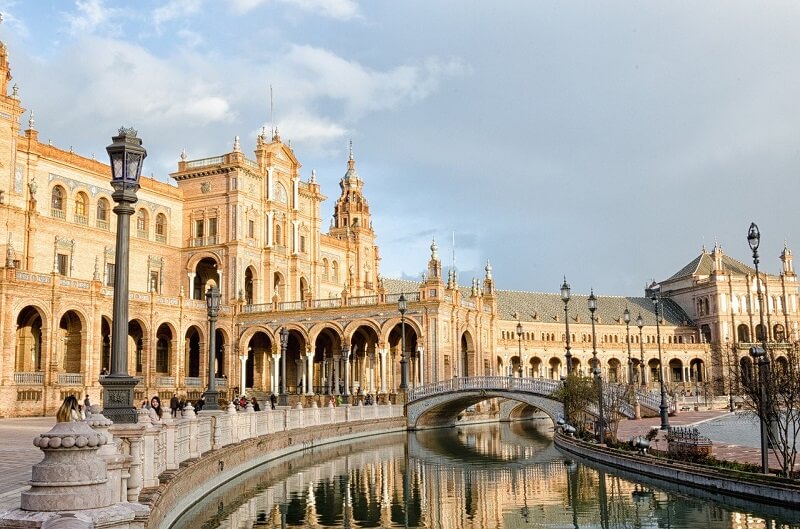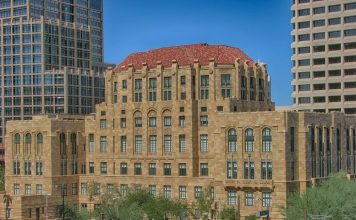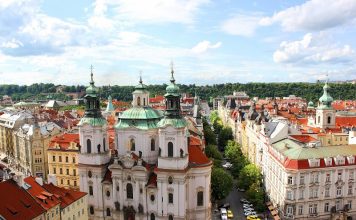Seville is the capital and largest city of the Andalusia region in southern Spain.
Seville is a beautiful and historic city in southern Spain, the capital of the region and province of Andalusia. It has about 700,000 inhabitants, making it the fourth largest city in Spain. It has a rich and diverse cultural heritage, influenced by the Romans, Moors, Jews and Christians who have lived there over the centuries.
Seville is famous for its monuments, such as the Seville Cathedral, the largest Gothic cathedral in the world, the Giralda, a former minaret turned into a bell tower, and the Alcázar, a stunning palace complex with exquisite gardens1. It is also known for its lively and colorful festivals, such as the Semana Santa (Holy Week) and the Feria de Abril (April Fair), where people dress up in traditional costumes, dance flamenco and enjoy the local cuisine.
Seville is a great destination for travelers who love art, history, gastronomy and entertainment. Some of the attractions that you can visit in Seville are: Plaza de España, a spectacular square with a fountain and tiled alcoves representing the provinces of Spain, Parque de María Luisa, a lush green park with exotic plants and birds, Metropol Parasol, a modern wooden structure that offers panoramic views of the city, and Casa de Pilatos, a Renaissance palace with a mix of Mudejar, Gothic and Romanesque styles.
What is Seville Known For?
It is famous for its rich cultural heritage, its stunning architecture, its lively festivals and its delicious cuisine. Some of the most iconic attractions in Seville include:
The Alcázar of Seville
The Alcázar of Seville, a royal palace that blends Islamic, Gothic, Renaissance and Baroque styles and features beautiful gardens and courtyards.
The Alcázar of Seville is a royal palace in Seville, Spain, that was originally built by the Moorish Muslim kings in the 10th century. The word “alcázar” means “fortress” or “palace” in Arabic, and the palace was designed to be a defensive and residential complex for the rulers and their court. The palace was expanded and renovated over the centuries by different dynasties and monarchs, who added new elements and styles to the original Islamic architecture. The result is a stunning blend of mudéjar, Gothic, Renaissance and Baroque styles, that reflects the rich cultural and artistic heritage of Seville.
The Alcázar of Seville is divided into several sections, each with its own history and features. Some of the most notable sections are:
- The Patio de las Doncellas (Courtyard of the Maidens), which was the main courtyard of the palace and the center of the official life. It has a rectangular pool surrounded by arcades and columns, and decorated with geometric and floral motifs.
- The Salón de Embajadores (Hall of Ambassadors), which was the throne room and the most important room of the palace. It has a stunning dome that represents the universe and the stars, and walls covered with tiles and inscriptions.
- The Cuarto Real Alto (Upper Royal Quarters), which are the private chambers of the royal family and their guests. They have richly furnished rooms, such as the bedroom of King Pedro I, the dressing room of Queen Isabel II and the chapel of King Carlos V.
- The Palacio Gótico (Gothic Palace), which was built by King Alfonso X in the 13th century and later modified by King Pedro I. It has a Gothic style and features the Sala de la Justicia (Hall of Justice), where the king administered justice, and the Patio del Crucero (Crossing Courtyard), which has a fountain and a cross.
- The Jardines del Alcázar (Gardens of the Alcázar), which are a vast and beautiful area of greenery and water features that surround the palace. They have different sections, such as the Jardín de la Danza (Garden of the Dance), the Jardín de las Damas (Garden of the Ladies) and the Jardín de la Mercurio (Garden of Mercury), and are home to many plants, birds and fountains.
The Alcázar of Seville is the oldest royal palace still in use in Europe and a UNESCO World Heritage Site. It is also a popular filming location for movies and TV shows, such as Game of Thrones. It is a must-see attraction for anyone who visits Seville and wants to admire its beauty and history.
The Seville Cathedral
The Seville Cathedral, the largest Gothic cathedral in the world and the burial site of Christopher Columbus.
The Seville Cathedral is a Roman Catholic cathedral in Seville, Spain, that was built on the site of a former mosque in the 15th and 16th centuries. It is the largest Gothic cathedral in the world and the third largest church in the world, after St. Peter’s in Rome and St. Paul’s in London. It is also a UNESCO World Heritage Site, along with the Alcázar of Seville and the General Archive of the Indies.
The Seville Cathedral has a rich history and architecture, and contains many treasures and artworks, such as the tomb of Christopher Columbus, the altarpiece of the main chapel, the Giralda tower, the Patio de los Naranjos and the Royal Chapel. It is also the place where many kings and nobles were baptized, crowned and buried, such as Ferdinand III of Castile, Alfonso X the Wise and Pedro I the Cruel.
The Seville Cathedral is one of the most visited monuments in Seville and a symbol of the city’s religious and cultural heritage. It is a must-see attraction for anyone who wants to admire its beauty and grandeur.
The Giralda
The Giralda, a former minaret that is now the bell tower of the cathedral and offers panoramic views of the city.
The Giralda of Seville is the bell tower of the Seville Cathedral and one of the most iconic landmarks of the city. It was originally built as the minaret of the Great Mosque of Seville in the 12th century by the Almohad dynasty, who ruled over al-Andalus, the Muslim territory in Spain. It has a square base and a height of 97.5 meters, and it was the tallest tower in the world at the time of its construction.
After the Christian reconquest of Seville in 1248, the mosque was converted into a cathedral and the minaret was preserved as its bell tower. In the 16th century, a Renaissance-style belfry was added on top of the minaret, with a bronze weathervane called the Giraldillo, representing faith, that gives the tower its name.
The Giralda of Seville is a masterpiece of Islamic and Christian architecture, and a symbol of the cultural fusion of Seville. It is also a UNESCO World Heritage Site, along with the Cathedral and the Alcázar of Seville. It offers a spectacular view of the city from its upper balcony, which can be reached by climbing 35 ramps inside the tower.
The Plaza de España
The Plaza de España, a spectacular square that showcases the regional diversity of Spain with tiled alcoves, fountains and bridges.
The Plaza de España of Seville is a stunning plaza and palace complex in the Maria Luisa Park, in Seville, Spain. It was built in 1928 by the architect Aníbal González for the Ibero-American Exposition of 1929, a world fair that showcased the culture and history of Spain and its former colonies in Latin America.
The Plaza de España is a masterpiece of Regionalism Architecture, a style that combines elements of the Baroque, Renaissance and Moorish traditions of Spanish architecture. It has a semicircular shape, with a diameter of 200 meters, and is surrounded by a canal and four bridges that represent the four ancient kingdoms of Spain. It also has a central fountain, a tower at each end, and a series of alcoves along the walls that depict the 48 provinces of Spain with colorful ceramic tiles.
The Plaza de España of Seville is one of the most beautiful and impressive monuments in the city, and a popular tourist attraction. It has also been featured in several movies, such as Lawrence of Arabia, Star Wars: Episode II – Attack of the Clones and The Dictator.
The Metropol Parasol
The Metropol Parasol, a modern wooden structure that resembles a giant mushroom and houses a museum, a market and a rooftop terrace.
Metropol Parasol is a wooden structure located at La Encarnación square in the old quarter of Seville, Spain. It is also known as the Mushrooms of Seville or Las Setas, because of its shape resembling giant mushrooms. It was designed by the German architect Jürgen Mayer and completed in April 2011.
Metropol Parasol is the largest wooden structure in the world, with a surface area of 11,000 square meters and a height of 26 meters. It consists of six parasols that form a canopy over the square, creating a shaded space for various activities. It also has two concrete columns that house the elevators to access the rooftop walkway, which offers panoramic views of the city.
Metropol Parasol is a modern and innovative landmark that contrasts with the historical and traditional architecture of Seville. It is also a cultural and commercial hub, as it hosts a museum, a market, a restaurant and a bar under its parasols.
The Real Maestranza
The Real Maestranza, a bullring that hosts the famous Feria de Abril, a spring festival that celebrates the traditions of flamenco, bullfighting and horse riding.
Metropol Parasol is a wooden structure located at La Encarnación square in the old quarter of Seville, Spain. It is also known as the Mushrooms of Seville or Las Setas, because of its shape resembling giant mushrooms. It was designed by the German architect Jürgen Mayer and completed in April 2011.
Metropol Parasol is the largest wooden structure in the world, with a surface area of 11,000 square meters and a height of 26 meters. It consists of six parasols that form a canopy over the square, creating a shaded space for various activities. It also has two concrete columns that house the elevators to access the rooftop walkway, which offers panoramic views of the city.
Metropol Parasol is a modern and innovative landmark that contrasts with the historical and traditional architecture of Seville. It is also a cultural and commercial hub, as it hosts a museum, a market, a restaurant and a bar under its parasols.
The Barrio Santa Cruz
The Barrio Santa Cruz, the old Jewish quarter that is full of narrow streets, colorful houses, charming plazas and tapas bars.
Barrio Santa Cruz is a neighborhood in the old town of Seville, Spain. It is the former Jewish quarter of the city, where the Jewish community lived from the 12th to the 15th century, until they were expelled or forced to convert to Christianity by the Catholic Monarchs.
Barrio Santa Cruz is one of the most charming and picturesque areas of Seville, with its narrow streets, whitewashed houses, flower-filled balconies and hidden courtyards. It is also home to some of the most important monuments of the city, such as the Cathedral, the Giralda Tower, the Alcázar Palace and the Archivo de Indias, all of which are UNESCO World Heritage Sites.
Barrio Santa Cruz is a lively and vibrant neighborhood, where you can find many restaurants, bars, shops, museums and cultural activities. It is also a place of history and legends, where you can discover the stories of famous characters who lived or passed by here, such as Don Juan, Carmen, Murillo or Cervantes.
The Torre del Oro
The Torre del Oro, a 13th-century tower that was once part of the city’s defensive walls and now houses a naval museum.
Torre del Oro (Tower of Gold) is a military watchtower in Seville, Spain. It is located on the left bank of the Guadalquivir river, next to the bullring of the Real Maestranza. It was built by the Almohad Caliphate in the 13th century to control access to Seville via the river and to defend the Alcázar palace.
Torre del Oro is 36 meters tall and has three levels. The first level, dodecagonal, was built in 1220-1221 by the Almohad governor of Seville, Abù l-Ulà. The second level, also dodecagonal, was added by Peter of Castile in the 14th century. The third level, circular, was added after the original Almohad level was damaged by the 1755 Lisbon earthquake.
Torre del Oro is named after the golden reflections that the tiles that covered it produced in its time. It also served as a prison, a chapel, a warehouse and a customs house. Today, it houses the Naval Museum of Seville, which displays historical documents, models, maps and navigation instruments related to the maritime history of Seville.
Traditional Dishes of Seville
Seville is also famous for its cuisine, which reflects the influences of the various cultures that have shaped the city’s history. Some of the most typical dishes in Seville include:
Gazpacho
Gazpacho, a cold soup made of tomatoes, cucumbers, peppers, garlic, bread and olive oil.
Gazpacho is a cold soup dish, originally from the southern region of Andalusia in Spain. It is made of blended or chopped raw vegetables, especially tomatoes, garlic, bread, olive oil, salt, vinegar or lemon juice. It may also include cucumbers, bell peppers, onion and spices.
Gazpacho is a refreshing and nutritious food for the summer, served as a snack or a starter. It can be found in supermarkets, packaged as juice, or in restaurants, where it is often accompanied by chopped vegetables or bread as toppings.
Sevillanos are believed to be among the first people who added tomatoes and bell peppers to the ancient Roman soup of garlic, bread, olive oil, salt and vinegar. In Seville and Andalusia in general, gazpacho has a rich taste of olive oil and is of creamy orange color, not as red as in other regions of Spain.
Tortilla de patatas
Tortilla de patatas, a thick omelette with potatoes and onions.
Tortilla de patatas (potato omelette) is a traditional Spanish dish, consisting of eggs, potatoes, onion and salt, cooked in a frying pan. It is usually served as a tapa, a snack or a main course, and can be eaten hot or cold.
Tortilla de patatas is very popular in Seville, where it is often prepared with a large size and a medium consistency, not too runny or too dry. Some people also add other ingredients, such as peppers, chorizo, cheese or ham.
Tortilla de patatas can be found in many bars and restaurants in Seville, where it is usually accompanied by bread, salad or other tapas. Some of the places where you can eat the best tortillas de patatas in Seville are: Bar Alfalfa, Bar Europa, Comidas para llevar La Esperanza, Bar La Antigua Abacería and Tortilla’s.
Jamón ibérico
Jamón ibérico, a cured ham from black pigs that feed on acorns.
Jamón ibérico (Iberian ham) is a type of cured ham made from the Iberian pig, a native breed of Spain and Portugal. It is highly regarded in the Spanish and Portuguese gastronomy as a delicacy and a gourmet product.
Jamón ibérico is produced by salting and drying the hind legs of the pig, which are then aged for at least 24 months in special cellars. The quality and flavor of the ham depend on the breed, the diet and the curing process of the pig. The best jamón ibérico comes from the pigs that are fed exclusively on acorns and roam freely in the oak forests of the southwest of Spain. This type of ham is called jamón ibérico de bellota (acorn-fed Iberian ham) and has a distinctive nutty taste and a melt-in-your-mouth texture.
Jamón ibérico is very popular in Seville, where it is served as a tapa, a snack or a main course, and can be eaten on its own or with bread, cheese, wine or other products. Some of the places where you can buy or eat the best jamón ibérico in Seville are: Corta y Cata, Maestro Marcelino, La Antigua Abacería, Bar Alfalfa and Bar Europa. You can also take a jamón tour to visit a jamón processing factory or a pata negra pig farm and learn more about the production and tasting of this exquisite ham.
Jamón ibérico was also part of the menu for the VIP guests of the Goya Awards 2023, celebrated in Seville last Saturday, along with shrimp, lobster brioche and other dishes.
Croquetas
Croquetas, fried balls of béchamel sauce with different fillings, such as ham, cheese, chicken or spinach.
Croquetas (croquettes) are a typical Spanish dish, consisting of small balls of béchamel sauce mixed with different ingredients, such as ham, cheese, chicken, spinach, cod or mushrooms, coated with breadcrumbs and fried until golden and crispy.
Croquetas are very popular in Seville, where they are served as a tapa, a snack or a main course, and can be eaten on their own or with bread, salad or other tapas. They are usually homemade, with a creamy and smooth texture and a light and crunchy crust. Some of the most common and delicious croquetas in Seville are: croquetas de jamón ibérico (Iberian ham croquettes), croquetas de pringá (pork steak croquettes), croquetas de espinacas con pasas y piñones (spinach with raisins and pine nuts croquettes) and croquetas de rabo de toro (bull’s tail croquettes).
Croquetas can be found in many bars and restaurants in Seville, where they are usually made fresh and served hot. Some of the places where you can eat the best croquetas in Seville are: Casa Ricardo, Islamorada Tapas Bar, Bar Alfalfa, Bar Europa, La Antigua Abacería, Bar La Azotea and Bar El Rinconcillo.
Salmorejo
Salmorejo, a thicker version of gazpacho that is topped with hard-boiled eggs and ham.
Montaditos, small sandwiches with various toppings, such as cheese, tuna, pork or anchovies.
Salmorejo is a cold tomato soup that is similar to gazpacho, but thicker and creamier. It is made of skinned tomatoes, extra virgin olive oil, garlic, bread, vinegar and salt, blended until smooth and velvety. It is traditionally served with hard boiled eggs and cured ham, chopped and sprinkled on top.
Salmorejo is a typical dish of the Andalusian cuisine, especially from Córdoba, where it has its ancient roots. According to some sources, people in this area have been making a version of the dish since they started cultivating wheat. However, salmorejo is also very popular in Seville, where it is a refreshing and nourishing option for the hot summer days. It can be eaten as a starter, a main course or a snack, and can be found in many bars and restaurants in the city.
Some of the places where you can eat the best salmorejo in Seville are: Bodeguita Romero, Bar Alfalfa, Bar Europa, La Antigua Abacería, Bar El Rinconcillo and Bar La Azotea.
Torrijas
Torrijas, a dessert made of bread soaked in milk, eggs and sugar and fried in oil.
orrijas are a typical Spanish dessert, especially during Easter. They are slices of bread soaked in milk or wine with spices and honey, coated with egg and then fried until golden and crispy. They are usually sprinkled with sugar, cinnamon or more honey, and sometimes served with cream or ice cream.
Torrijas are a very old dish, dating back to the Roman times, when they used to dip bread in honey. They were also a popular food among the poor, who used stale bread to make them. They became associated with Easter as a way of using up the bread during Lent, when meat was forbidden.
Torrijas are very popular in Seville, where they have their own recipe and style. The Sevillian torrijas are usually made with a special bread called pan de torrijas, which is denser and more compact than regular bread. They are also soaked in a local wine called Montilla-Moriles, similar to sherry, and covered with a generous amount of honey. They are a sweet and rich treat, perfect for the spring season.
Torrijas can be found in many bakeries, pastry shops and bars in Seville, where they are freshly made and served warm or cold. Some of the places where you can eat the best torrijas in Seville are: La Campana, La Dulcería Triana, Manu Jara, Confitería La Campana, Confitería La Centenaria and Confitería Ochoa.
Famous Drinks in Seville
Seville is famous for some drinks that are typical of the region and reflect its culture and climate. Some of the drinks that you can try in Seville are:
Orange wine: a sweet and aromatic wine made from oranges and white wine, usually served as an aperitif or dessert.
Manzanilla: a dry and pale sherry wine that is produced in the coastal town of Sanlúcar de Barrameda, near Seville. It has a delicate and salty flavor that pairs well with seafood and tapas.
Amontillado: another type of sherry wine that is aged longer than manzanilla and has a darker and nuttier taste. It is often served with cheese, ham and nuts.
Cruzcampo: the most popular beer brand in Seville and Andalusia, founded in 1904. It is a light and refreshing lager that is perfect for the hot weather.
Tinto de verano: a refreshing drink made from red wine and lemon soda, usually served with ice and a slice of lemon. It is similar to sangria but simpler and less sweet.
Mosto: a non-alcoholic drink made from freshly pressed grape juice that has not been fermented. It is usually served in winter and has a fruity and slightly sour flavor.
Rebujito: a festive drink that is typical of the Feria de Abril, a week-long celebration of music, dance and food in Seville. It is made from manzanilla sherry and 7Up, and served with ice and mint leaves.
Famous Sports in Seville
Seville is a city that loves sports and has hosted many international sporting events in the past. Some of the sports that Seville is famous for are:
Soccer (Football / Fútbol): Seville has two rival soccer teams, Sevilla FC and Real Betis Balompié, that play in the top division of the Spanish league. They have a passionate fan base and a fierce derby match that is one of the most intense in the country.
Basketball: Seville has a professional basketball team, Coosur Real Betis, that plays in the Liga ACB, the highest level of Spanish basketball. They have won several national and international titles and play their home games at the San Pablo Sports Complex.
Golf: Seville has several golf courses that cater to different levels of players and offer scenic views of the city and the countryside. Some of the most popular golf courses are Real Club de Golf de Sevilla, Zaudín Golf Club, Club de Golf Hato Verde and Club de Golf Las Minas.
Bullfighting: Seville is one of the most important centers of bullfighting in Spain and has a long and rich tradition of this controversial sport. The Plaza de Toros de la Maestranza is the oldest bullring in the country and hosts some of the most prestigious bullfights during the spring season.
Cycling: Seville is a bike-friendly city that has a network of bike lanes and paths that cover more than 180 km. You can rent a bike from one of the many public stations or join a guided bike tour to explore the city and its surroundings. Some of the best routes are along the Guadalquivir River, the Alamillo Park, the Maria Luisa Park and the Triana neighborhood.
Equestrian Sports: Seville has a strong connection to horses and equestrian sports, especially in the Andalusian countryside. You can visit some of the horse farms and riding schools that breed and train the famous Andalusian horses, or watch some of the equestrian shows and competitions that take place throughout the year. Some of the most notable events are the SICAB International Horse Fair, the Royal Andalusian School of Equestrian Art and the Carriage Driving Competition.
Watersports: Seville has a variety of watersports that you can enjoy on the Guadalquivir River or the nearby beaches. You can try kayaking, canoeing, rowing, sailing, windsurfing, kitesurfing, surfing, stand-up paddle boarding and more. Some of the places where you can practice these sports are the Isla de la Cartuja, the Club Náutico Sevilla, the Club de Remo Guadalquivir 86 and the Club de Piragüismo Triana.
Famous Streets in Seville
Seville has many streets that are famous for their history, culture, architecture and atmosphere. Some of the most popular streets in Seville are:
Calle Sierpes: the most famous street in Seville, a pedestrian-only road that runs through the historic center and is full of tapas bars, restaurants, shops and charm.
Avenida de la Constitución: one of the most notable streets in Seville, a wide avenue that runs through the heart of the city and is lined with beautiful old landmarks and shops, such as the Cathedral, the Giralda, the Town Hall and the Archivo de Indias.
Calle Feria: one of the few popular streets that still has its local shops, restaurants, stores and inhabitants. It has the traditional Feria Market, one of the most charming in all of Seville, and the Omnium Sanctorum Church, a Gothic-Mudejar gem.
Calle Betis: a picturesque street that runs along the Guadalquivir River in the Triana neighborhood, offering stunning views of the city skyline and the Torre del Oro. It is a lively area with many bars, restaurants, terraces and flamenco venues.
Calle Mateos Gago: a narrow street that connects the Plaza del Triunfo with the Plaza de Santa Cruz, two of the most emblematic squares in Seville. It is a popular spot for tourists and locals alike, as it offers a great view of the Giralda and has many tapas bars and souvenir shops.
Seville is a city that offers something for everyone, whether you are interested in history, art, culture, gastronomy or entertainment. It is a city that will captivate you with its charm, its beauty and its spirit. Seville is a city that you will never forget.
FAQs about Seville
How can I get to Seville from the airport?
Seville has an international airport that is located about 10 km from the city center. You can take a bus, a taxi or a private transfer to get to your accommodation. The bus runs every 25 minutes and costs 4 euros. The taxi costs around 25 euros and takes about 15 minutes. The private transfer can be booked online and costs around 30 euros.
How can I book a private guided tour in Seville?
Seville has many options for private guided tours that can help you discover the city in a more personalized and comfortable way. You can book a private guided tour online, by phone or by email, depending on the company or the guide that you choose. You can find different types of tours, such as walking tours, bike tours, segway tours, boat tours, food tours, cultural tours, historical tours and more. You can also customize your tour according to your interests, needs and budget.
When is the best time to visit Seville?
Seville has a Mediterranean climate that is characterized by hot summers and mild winters. The best time to visit Seville depends on your preferences and what you want to see and do. Generally, the spring and the autumn are the most pleasant seasons, as the temperatures are moderate and the city is full of colors and festivities. The summer can be very hot and dry, with temperatures reaching 40 degrees Celsius, but it is also less crowded and cheaper. The winter can be cold and rainy, but it is also a good time to enjoy the Christmas markets, the lights and the nativity scenes.
See more Famous Places in Spain:
- What is Seville Famous For?
- What is Cadiz Famous For?
- What is Huelva Famous For?
- What is Caceres Famous For?
- What is Granada Famous For?
- What is Madrid Famous For?
- What is Barcelona Famous For?
- What is Valencia Famous For?
- What is Almeria Famous For?
- What is San Sebastian Famous For?
- What is Santanter Famous For?
- What is Salamanca Famous For?
- What is Oviedo Famous For?
- What is Valladolid Famous For?
- What is Cordoba Famous For?
- What is Alicante Famous For?
- What is Bilbao Famous For?
- What is Palma Famous For?
- What is Murcia Famous For?
- What is Zaragoza Famous For?
















